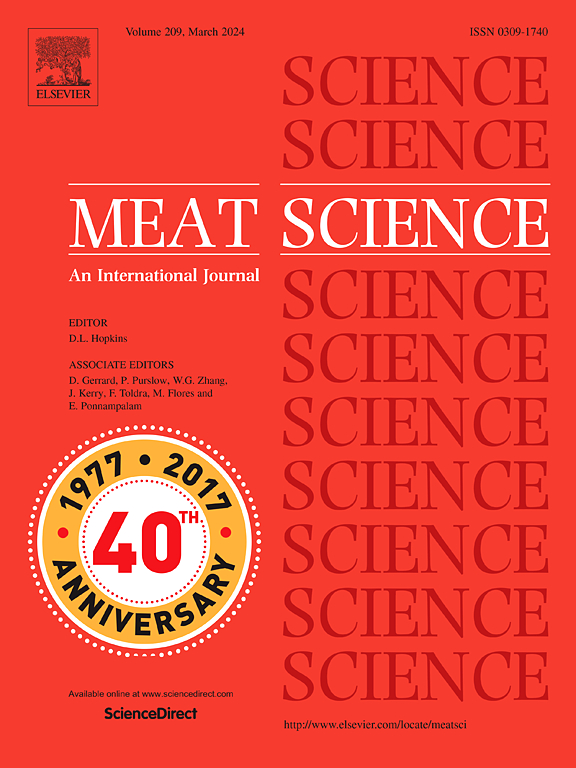洋蓟青贮在肉牛育肥期饲粮中的作用:干老化期间的肉质
IF 6.1
1区 农林科学
Q1 Agricultural and Biological Sciences
引用次数: 0
摘要
本研究评价了育肥牛日粮中添加洋蓟青贮对干熟肉质质的影响。将阉牛分为3种饲粮处理,用洋蓟苞青贮部分替代麦秸。屠宰后,将带骨壳腰肉干熟42天,在不同时间点采集样品,评估理化性质、氧化稳定性和脂肪酸组成。采用完全随机设计;采用双向方差分析确定饮食处理和老化时间的影响。结果表明,陈化对水分损失、保水能力和剪切力有显著影响,且在前14 ~ 21 d变化最为显著。在腰肉产量、肉嫩度或烹调损失方面,饮食处理之间没有发现显著差异。洋蓟苞青贮延缓了脂质氧化,与对照组相比,处理组的硫代巴比妥酸活性物质值较低。此外,饲喂洋蓟花苞青贮的阉牛的肉表现出比色参数的差异,这可能与较低的氧化过程有关。脂肪酸分析显示,治疗组的饱和、单不饱和和多不饱和脂肪酸浓度明显较高,可能是由于肌内脂肪含量增加。这些发现表明,朝鲜蓟青贮饲料可以作为一种可行的替代饲料成分,在保持干熟牛肉氧化稳定性的同时,提供潜在的经济和环境效益。这些成分变化的感官意义及其对干陈酿过程中风味发展的影响有待进一步研究。本文章由计算机程序翻译,如有差异,请以英文原文为准。
Artichoke bracts silage in the finishing diet of beef steers: Meat quality during dry aging
This study evaluated the effects of including artichoke bracts silage in the diet of finishing beef steers on the quality of dry-aged meat. Steers were divided into three dietary treatments, where artichoke bracts silage partially replaced wheat straw. Following slaughter, bone-in shell loins were dry-aged for 42 days, samples were collected at different time points to assess physicochemical properties, oxidative stability, and fatty acid composition. A completely randomized design was used; data were analyzed using a two-way ANOVA to determine the effects of dietary treatment and aging time. The results showed that aging significantly influenced moisture loss, water-holding capacity, and shear force, with the most notable changes occurring within the first 14–21 days. No significant differences were found between dietary treatments in terms of loin yield, meat tenderness, or cooking loss. The inclusion of artichoke bracts silage delayed lipid oxidation, as indicated by lower thiobarbituric acid reactive substances values in treated groups compared to the control. Additionally, meat from steers fed artichoke bracts silage exhibited differences in colorimetric parameters which may be associated with lower oxidative processes. Fatty acid analysis revealed significantly higher concentrations of saturated, monounsaturated, and polyunsaturated fatty acids in treated groups, likely due to increased intramuscular fat content. These findings suggest that artichoke bracts silage can be a viable alternative feed ingredient, offering potential economic and environmental benefits while maintaining oxidative stability in dry-aged beef. Further research is needed to explore the sensory implications of these compositional changes and their effects on flavor development during dry aging.
求助全文
通过发布文献求助,成功后即可免费获取论文全文。
去求助
来源期刊

Meat Science
工程技术-食品科技
CiteScore
12.60
自引率
9.90%
发文量
282
审稿时长
60 days
期刊介绍:
The aim of Meat Science is to serve as a suitable platform for the dissemination of interdisciplinary and international knowledge on all factors influencing the properties of meat. While the journal primarily focuses on the flesh of mammals, contributions related to poultry will be considered if they enhance the overall understanding of the relationship between muscle nature and meat quality post mortem. Additionally, papers on large birds (e.g., emus, ostriches) as well as wild-captured mammals and crocodiles will be welcomed.
 求助内容:
求助内容: 应助结果提醒方式:
应助结果提醒方式:


